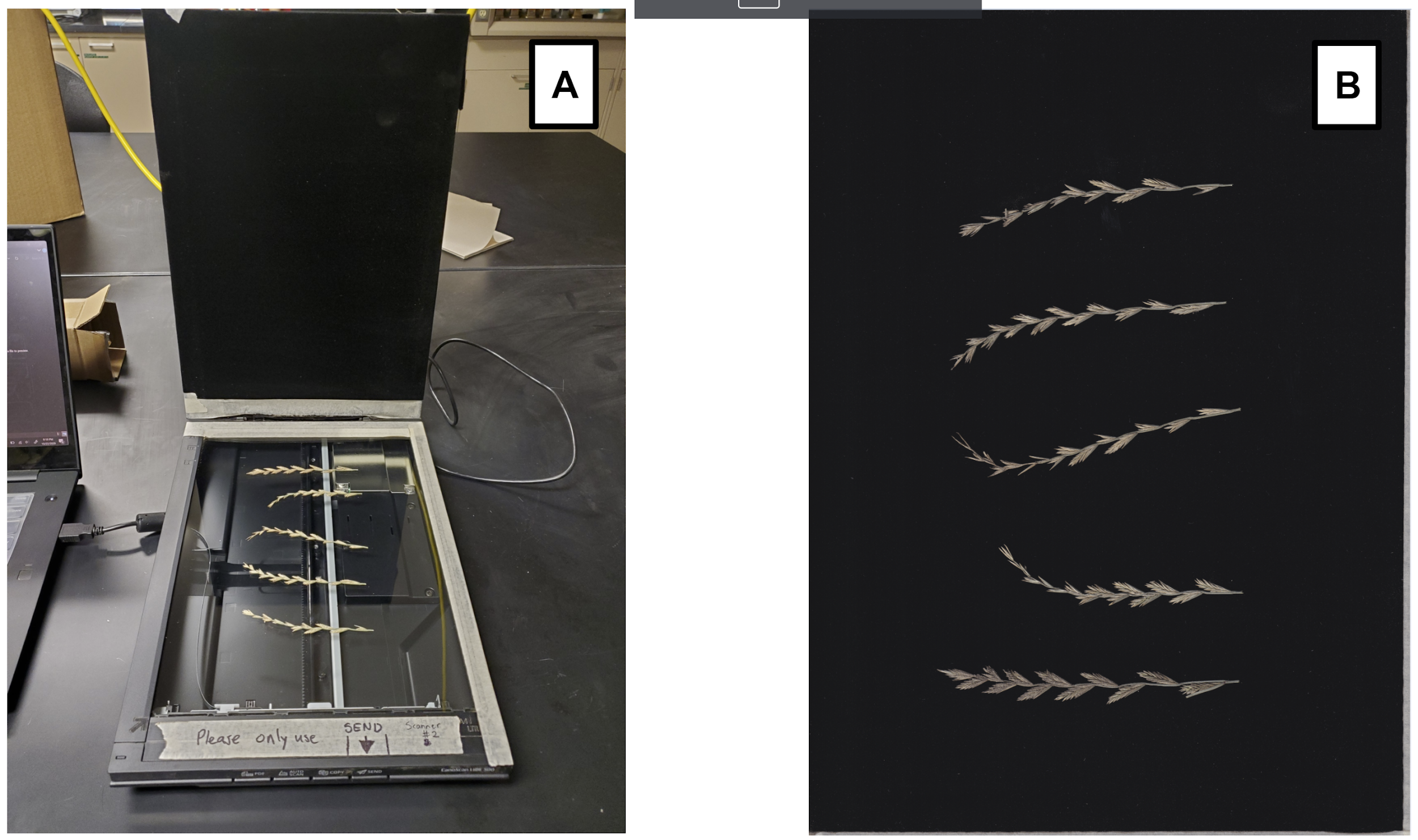By Joan M. Barreto Ortiz
This past summer was very productive as we continue studying the genetics controlling seed shattering in perennial ryegrass (Lolium perenne L.). While it was warm out, we established a shattering nursery that comprised different families of this globally important forage and turf species at UMN Turfgrass Research Outreach Education Center (TROE; Figure 1). The first step was transplanting 800 individuals that had been vernalizing in a cooler for approximately 13 weeks at 6°C. The plants were set in four blocks (200 plants per block), each containing a combination of maternal and half sibling plants (Figure 1B). The idea was to estimate how much variation for seed shattering was due to genetics instead of the environment, in other words, nature vs. nurture (check out my previous blog post to learn why we are interested in shattering). Although not every single plant produced multiple spikes (inflorescences), we collected enough samples to induce shattering and estimate seed yield. In addition, we aim to understand morphological aspects of the spike that contribute to these agronomic traits using image analysis.
Working during this field season was not an easy task. First, the current pandemic challenged our data collection process by limiting the amount of people we could have working at the same time. Moreover, we could only start harvesting after 11 AM to avoid the morning dew, which required us to work during the hottest time of the day. Harvesting was also physically difficult as we had to bend over for long periods of time looking for mature spikes across multiple individuals. Not to mention that determining whether a spike is ready to be harvested or not is already a big challenge due to the asynchronous-flowering nature of this species. Luckily, we had extremely smart and hardworking women, in particular Amara Jackson, Bailey Tangen and Catherine Jackson, who along with the rest of our crew made this a productive field season. The spikes were harvested by cutting at approximately one inch of stem from the lowest spikelet and immediately placing them in an envelope for further processing. Lodging and rust were also scored during harvesting using a 0-5 scale where zero is no lodging or rust, and 5 represents the maximum values for the traits.
Now with the current chilling temperatures and snow, it is time to process our samples indoors. To do so, we will carry out four important steps. First, we take pictures of a subset of spikes for further image analysis. These images are obtained by placing a subset of the spikes in a flatbed scanner using a black velvet as a background to increase contrast (Figure 2). From these images, we expect to get multiple measurements such as spike length, width, area, color, number of spikelets, etc, using MATLAB and Python as described in a previous blog post. As a second step, the spikes are dried at 95°C for 48 hours. This is required to guarantee approximately the same seed moisture content across samples, which is a major determinant of seed shattering.
The next step is to induce and estimate seed shattering. To do so, we mechanically detach the seeds from the spikes using wrist-action shakers that were kindly lent by Dr. Michael Sadowsky at the BioTechnology Institute and Dr. Pam Rice at the USDA. The spikes, which have no more than 0.5 mm of stem, are placed upside down in aluminum cylinders of 10-inch length and 2-inch diameter that are each fitted with a 0.8 mm mesh in the bottom to let through any potential dust. The shaker is turned on for 5 minutes at its standard speed (385 rpm) and an oscillating angle of 15° (Figure 3). This mechanical shaker does not exactly represent shattering in the field. However, it helps us identify which plants may be genetically more susceptible to detach seeds under similar mechanical force. Once we have shaken the spikes, we weigh the detached seed and the spike with the remaining seed, which will be used to estimate seed yield.
The fourth and final step involves manually threshing the spikes that still hold seed after shattering induction, and weigh both the stem and the remaining seed (Figure 4). We are interested in knowing the stem’s weight because this information can be useful when studying spike morphology and particularly branching features. It is possible that the plants spend unnecessary resources making unproductive stems and that could be a trait that we could breed for. The total seed yield per spike will be the sum of the seed that remained attached and the detached seed (shattering).
As we process our current samples we already plan to repeat these measurements in a new field next season. We don't know if our current field at TROE will survive the winter as perennial rye often lacks winter hardiness, but thanks to assistance from Gary Deters we planted spring wheat in between our plants to help make sure the plants are covered with snow as much as possible to prevent exposure to extremely low temperatures (Figure 5).




